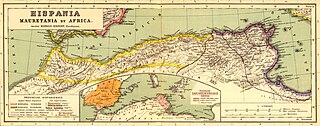Related Research Articles
Parthenia was a Roman–Berber town in the former Roman province of Mauretania Sitifensis, the easternmost part of ancient Mauretania. It was located in what is now northern Algeria.

Zuccabar was an ancient town in the Roman province of Mauretania Caesariensis. It is located in present-day Miliana, Algeria.
Beniane is a town and commune in Mascara Province, Algeria at the site of ancient Ala Miliaria, a former bishopric which earns a Latin Catholic titular see.

Quiza also known as Vuiza (Βούϊζα), which Pliny the Elder called Quiza Xenitana, was a Roman–Berber colonia, located in the former province of Mauretania Caesariensis. The town is identified with ruins at Sidi Bellater, Algiers.

Khemisti is a town and commune in Tissemsilt Province in northern Algeria. It was called Bourbaki when Algeria was a colony of France.
Tigisis, also known as Tigisis in Mauretania to distinguish it from another Tigisis in Numidia, was an ancient Berber town in the province of Mauretania Caesariensis. It was mentioned in the Antonine Itinerary.
Taborenta, Mauretania Caesariensis was a Berber civitas (town) and bishopric in Roman North Africa. It disappeared during the 7th century, and is assumed to be near Saida in modern Algeria. It was nominally restored in 1933 as a titular see.

Nasbinca was a Roman town of the Roman province of Mauretania Caesariensis. The location of Nasbinca is now lost to history but it was in today's Algeria. The town seems to have survived through late antiquity till at least the Muslim conquest of the Maghreb.
Satafi, was a Roman town in the Roman province of Mauretania Caesariensis, North Africa. It lasted through the Vandal Kingdom and Roman Empire, until at least the Muslim conquest of the Maghreb, in late antiquity. An exact location of the town is not known but, it was probably in Algeria.
The diocese of Vannida Latin: Dioecesis Vannidensis) is a suppressed and titular see of the Roman Catholic Church. It was centered on the ancient Roman town of Vannida, in what is today Algeria, is an ancient episcopal seat of the Roman province of Mauretania Caesariensis.

Sereddeli was an ancient Roman town of the Roman province of Mauretania Caesariensis, in North Africa. Sereddeli flourished through the Vandal Kingdom and Roman Empire into late antiquity. It survived until at least the Muslim conquest of the Maghreb.
The Diocese of Media is a suppressed and titular see of the Catholic Church. Media is listed as an ancient episcopal seat of the Roman province of Mauretania Caesariensis, in today's Algeria.
The Diocese of Mina was a Roman–Berber civitas and Roman Catholic diocese in Mauretania Caesariensis. It is a Catholic Church titular see.
The Diocese of Corniculana is a suppressed and titular see of the Roman Catholic Church.
The Diocese of Fronta is a suppressed and titular see of the Roman Catholic Church.

Numida was an ancient Roman town in the Roman province of Mauretania Caesariensis. It was located in modern northern Algeria.

Tamada was an ancient Roman–Berber civitas in the province of Mauretania Caesariensis. The town lasted through the Byzantine Empire, Vandal Kingdom and Roman Empire into late antiquity, until at least the Muslim conquest of the Maghreb in the 7th century.

The Diocese of Usinaza is a suppressed and titular see of the Roman Catholic Church, in the province of Mauretania Caesariensis.

The Diocese of Sufar, is an ancient episcopal seat of the Roman province of Mauretania Caesariensis. The location of the seat of the bishopric is now lost to history, but it was somewhere in today's Algeria.

The Diocese of Subbar is a suppressed and titular see of the Roman Catholic Church.
References
- ↑ Annuario Pontificio 2013 (Libreria Editrice Vaticana, 2013, ISBN 978-88-209-9070-1), p. 980
- ↑ Stefano Antonio Morcelli, Africa christiana, Volume I, Brescia 1816, p. 297
- ↑ Sophrone Pétridès, "Tadama" in Catholic Encyclopedia (New York 1912)